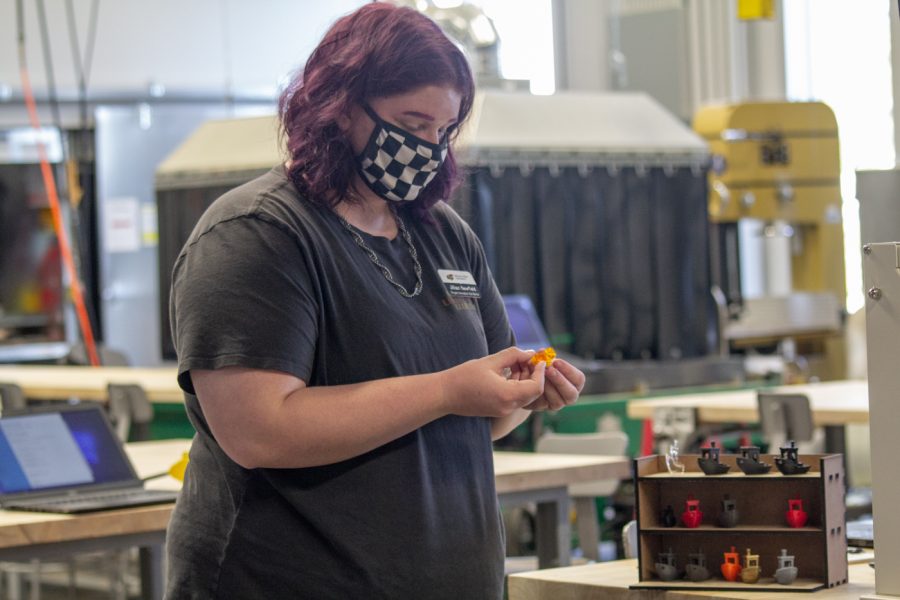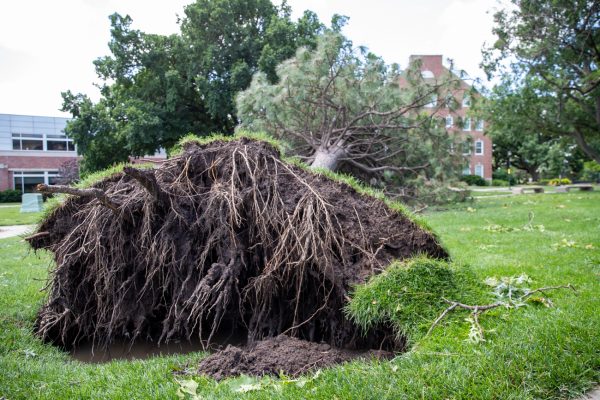‘Fail fast, learn faster:’ Innovation Hub gives students the opportunity to learn valuable lessons for the workforce
Rachel Rudisill/ The Sunflower
Jillian Newfield, a student worker at the Innovation Hub, examines and explains the differences between figurine ships made at the hub.
At the heart of the Innovation Hub — a space for students to turn their creation ideas into reality — are the student workers, who are passionate about the hub and want to share the valuable knowledge and lessons they have learned for their futures in engineering.
The Innovation Hub is located in the John Bardo Center on the innovation campus, with three floors including quiet space on the second floor to brainstorm ideas or have private conversations about projects.
Senior Jillian Newfield said that safety is important at the Innovation Hub. All PPE equipment, such as safety glasses, face shields, and safety gloves are provided to students at the hub.
Every machine in the Innovation Hub is ranked based on usability. For example, level 4 and 5 machines require more training and practice.
“Our first couple of levels, you can use them as long as you are safe and you know what you are doing,” Newfield said. “Most people know how to use a screwdriver.”
Newfield said that they want to make sure the machines and the people who are using them are okay. Joshua Stoner, a senior in physics, said that students shouldn’t let their fear of breaking something stop them from coming in.
“We would prefer if a student fail a job to learn why it failed, why this happened this way,” Stoner said. “We would see it more as an opportunity for them to learn … If they break it, we have money to replace that.”
The Innovation Hub workers usually see STEM, engineering, and art students coming in to use the lab, but want to emphasize that the hub is open to students of all majors, and they work side-by-side with students to teach them what they need to know. They also see more upperclassmen and want to encourage freshmen to visit as well.
“Part of it is just gaining confidence with these tools, because some of them are a little imposing … by using it and learning to use it safely, it gives you confidence in yourself that you can not only design something on a computer, but you can actually build what you could conceive of,” Dean of Engineering Anthony Muscat said.
Stoner said that they see a wide variety of projects, from students coming in to make Christmas presents for their families, to a student who has been working on a carbon-fire rocket from scratch for over a year now.
Along with learning the technical skills, Stoner said that he has also learned how to tell if something is going to fail before it actually does, which can save valuable time and money when students enter into the workforce.
Newfield said that she came into this position only this semester, but she had decided in seventh grade that she was going to go into engineering.
“When I was in seventh grade I took an engineering class and my instructor said that engineers solve problems and all I’ve ever really wanted to do was help people and I was like, ‘that makes sense, that’s what we’re doing,’ and I have stuck with it since,” Newfield said.
Newfield said that she loves WSU’s focus on hands-on experience, and enjoys working at the Innovation Hub because she has more creative freedom than working at an internship. She said she enjoys interacting with peers and is very interested in innovation and design.
“I think it’s given me more freedom on where I want to go as an engineering major, and it allows me to do a lot more projects than just doing things that don’t bring me joy,” Newfield said.
Thomas Nguyen, a senior in mechanical engineering, said that he started volunteering at the Innovation Hub back in 2017 because the Innovation Hub needed help getting started. He spent two months training and said it was a fun experience.
“I failed a lot, and I think it’s really important to fail,” Nguyen said. “In a sense, when you go to applied learning and you’re putting the knowledge from your academic, through your outside time into reality, you’re gonna find that things don’t work out the way you expected it to be.
“You are gonna mess up at some point, things aren’t going to be perfect, and I think that this lab is a great place because it exemplifies that it’s perfectly fine for you to fail.”
Stoner, who has been working at the lab for two years, said that the most valuable lesson he has learned is that projects will never come out perfect on the first try or even the next one. He said that he will usually go through at least seven iterations, and a couple more after that to get the perfect final product.
“The amount of iterations that you have to go through to actually have something work is by far the number one thing I have learned through here is that it is never going to work on the first time,” Stoner said. “If it does, it’s a lucky bloop or someone has done it multiple times and they gave you a little insight.”
Muscat said that future plans for the Innovation Hub include having laboratory classes use the tools in the hub to create and design a product, with the professor acting as a customer.
“Students would design, build, and then make some measurements that would illustrate some fundamental principle that is in their classes,” Muscat said. “The professor could pick the project in order to point the students in the general direction of the theory or fundamental principle.”
To learn more about the Innovation Hub and what they have to offer, click here.










williams steve • Oct 8, 2021 at 10:17 am
I have always had issues with payments irregularities, a credit score as low as 486, bad credit history so I can’t condole the hardness of paying up my debts, as a matter of fact I just loosed my job recently to cater for the kids is another burden on me since I’m a father of 3, So I contacted DOOM CREDIT GROUP when I saw someone recommend them for credit help on a credit blog, the recommendation I saw are all encouraging, I got in touch with them on phone and we discussed about the process and the way forward, they promised to help me out, I held their words and gave them a go ahead, within a couple of days my credit was perfectly fixed, no more evictions, bad reports, repos, everything was done appropriately without any cause for alarm, my credit score was also boosted to a very much encouraging rate, I can’t express to you guys how happy I am. This is a year of wonders and miracle in my life. You can as well get in contact with them on their information’s below and thank me late Contact: [email protected]___or +1(289)960-0524)